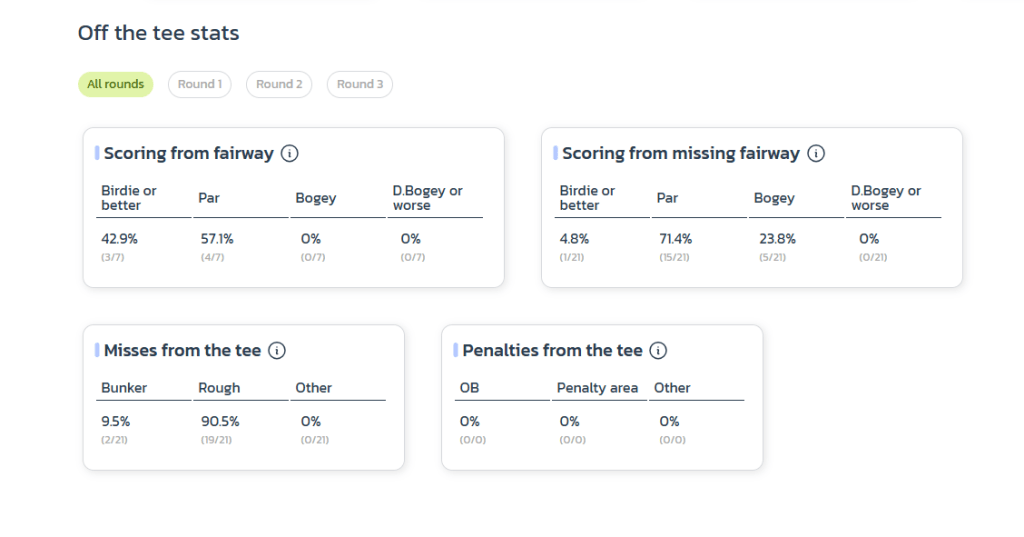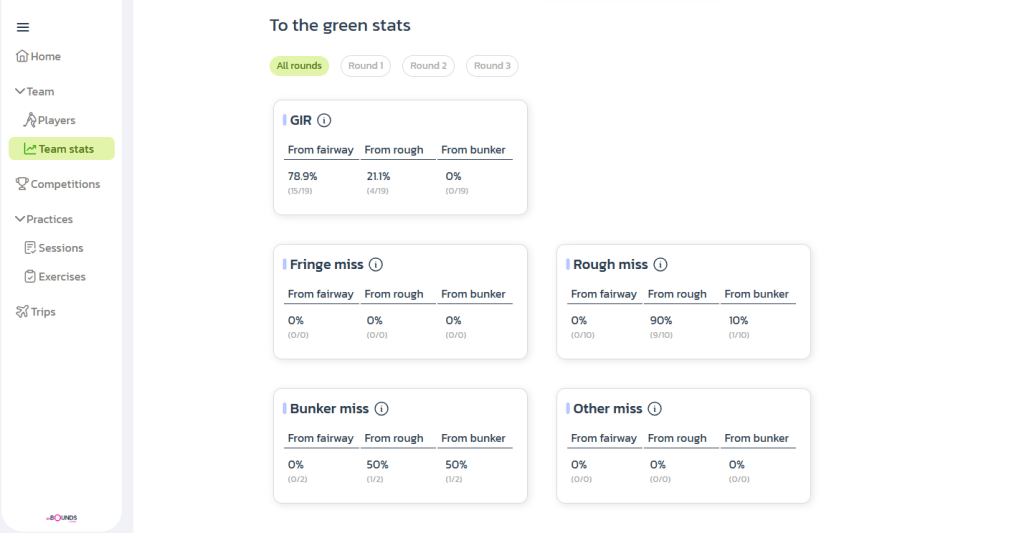The Open de España 2025 was held from October 9th to 12th at Club de Campo Villa de Madrid, and from the very first day, it was clear this would be a true test of precision. What we witnessed over those four days was not just another DP World Tour, but one of the most technically demanding golf tournaments in Spain in recent memory.
The course setup was as tough as we’ve seen in recent editions — narrow, firm fairways, dense rough, and fast, subtly breaking greens that challenged even the best putters. The conditions were fair but completely unforgiving. If you weren’t in full control off the tee, you were immediately playing catch-up for the rest of the hole.
Technology Meets Golf Strategy
One of the most interesting aspects of the Golf Open de España 2025 was watching how technology and analytics are becoming a true part of modern coaching.
Several coaches and players were actively tracking performance metrics in real time — monitoring strokes gained, fairway accuracy, proximity to the hole, and putting tendencies right from the ropes. It was encouraging to see that some of them were using InBounds to collect and interpret that data live, using insights to adapt strategy and understand exactly where shots were being won or lost.
Seeing data applied that way — not as numbers on a screen, but as a tool for decision-making and communication — was a reminder of how much the game is evolving. For us, it was a proud moment to realize that the same tools designed to help coaches and academies improve performance were now being used at such a high level of competition.

Precision Over Power: What Defined the Spanish Open 2025
What stood out most, though, was how small mistakes quickly turned into lost shots. A tee shot that missed the fairway by just a few yards often meant a ball buried in deep rough, with no angle to the green and no chance to be aggressive. Recovery options were limited — you had to play smart, play safe, and, when the chance came, execute perfectly.
By the weekend, only the most disciplined players remained in contention. As we followed the final groups through Saturday and Sunday, it became clear this wasn’t about who could go the lowest. It was about who could avoid damage, manage their game with patience, and make fewer mistakes than the rest of the field.
Our Thoughts: A Demanding Test of Precision
From our perspective walking the course, Club de Campo Villa de Madrid was a true test of control and discipline — far more than raw power. Missed fairways were punished, not just in theory but in measurable, statistical ways throughout the Open de España 2025.
We noticed several coaches and caddies relying more heavily on performance data and analytics than ever before. Tablets were used daily to review shot dispersion, strokes gained data, proximity stats, and putting maps. Players and teams were clearly applying more detail-oriented strategy — adjusting on the fly based on live metrics.
But no amount of data could save you if you weren’t hitting fairways. The rough was thick, unpredictable, and placed perfectly to penalize even slight errors. Missing the fairway often meant playing defensively — laying up, chipping out sideways, or punching low just to get back in position.
Statistically, players missing the fairway were losing between 0.3 and 0.5 strokes per hole, according to data we reviewed during the Golf Open de España 2025. The cumulative effect was huge: momentum was lost, rhythm broken, and confidence tested.
The Course Setup: Tight, Demanding, and Fair
Every tee shot mattered. The Spanish Open 2025 layout didn’t allow players to overpower it. Once you missed a fairway, angles disappeared, sightlines narrowed, and elevated greens made approach shots nearly impossible.
Players who found fairways stayed in rhythm, confidently attacking flags. Those who didn’t had to grind for pars, mentally and physically. Over 7,150 yards, the Club de Campo Villa de Madrid demanded patience, control, and discipline.

Our biggest takeaway? This was not a course that could be overpowered or outsmarted. It demanded smart decisions, conservative targets, and complete control of tempo and trajectory. Precision truly meant everything.
The best rounds — like Marco Penge’s winning performance — came from players who respected the course, played within its limits, and trusted their strategy.
How the Course Played: From Tee to Green
From the opening round, Club de Campo Villa de Madrid was clearly not giving away low scores. The design is traditional, but the combination of setup, conditions, and course strategy made it one of the most complete tests we’ve seen in a while.
Every missed shot—especially off the tee—was costly. The rough was thicker than usual, and fairways were playing firm and fast. A drive just a few yards offline often led to lost control over spin, launch, or shape on the next shot.
➤ Driving Accuracy: Down Across the Field
The field average for driving accuracy over the week was around 55%, noticeably lower than the Tour average of 60–65%. Some of the tightest holes, like the par-4 7th and 12th, saw fairway hit rates below 50%.
Players who ranked among the top 10 by Sunday were hitting closer to 65% of fairways and were almost all inside the top 20 in driving accuracy. That tells you everything. Missing the fairway wasn’t just a distance issue—it meant surrendering control and scrambling to limit damage.

➤ Greens in Regulation (GIR): Rough Made It Tough
GIR stats also suffered across the field. The average for the week was about 61%, which is below standard for this level of play. More telling, players who missed fairways were hitting less than 45% of greens in regulation.
In contrast, those who kept it in the fairway—especially the final contenders—were consistently above 70% GIR, including Marco Penge, who ultimately won the tournament. In fact, only 11 players all week managed to hit more than 70% of greens, and all finished T25 or better.

➤ Putting: Fast, Firm, and Mentally Draining
The greens added another layer of challenge. They weren’t overly contoured, but they were fast, firm, and subtly tricky. Even short putts required focus, and players struggled to convert chances.
The average putts per round was about 29.8, but the bigger factor was strokes gained putting. Players gaining over +1.5 strokes per round on the greens had a real chance to contend. Others, despite hitting the ball well, simply couldn’t keep pace.
We saw data showing some players losing 2+ strokes per round on the greens—often due to 3-putts from 25–30 feet or misreading slick downhill putts. The field averaged 1.79 putts per GIR, and over four rounds, that slowly drained momentum from many otherwise solid rounds.

Conclusion: Precision Still Reigns at the Open de España 2025
The 2025 Open de España reminded everyone that precision, patience, and smart strategy still matter — perhaps more than ever — when the course demands it.
At Club de Campo Villa de Madrid, success came from control and execution, not brute force. The narrow fairways, dense rough, and firm greens exposed every weakness and rewarded players who managed risk intelligently.
In a sport increasingly obsessed with distance, the Golf Open de España 2025 was a refreshing throwback to true championship golf — where thoughtful play and mental toughness define the winner.
Every shot counted, every decision mattered, and by the end of the week, we were reminded of why precision remains the ultimate skill in golf.

